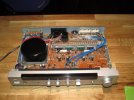knighterrant
New Member
hi, im looking for any technical data / specs or really any info about this Philips Amp i was given. Its a "High Speed A" pre-main amplifier
the model no is 23ah833, it seems to be 190Watt and manufactured by Philips Electrical industries New Zealand. i've attached photos of the interior and exterior - all i've been able to discover is its "rare" and has a "large Toroidal transformer" any help appreciated - im thinking maybe it was manufactured in other countries with a different model number-
the model no is 23ah833, it seems to be 190Watt and manufactured by Philips Electrical industries New Zealand. i've attached photos of the interior and exterior - all i've been able to discover is its "rare" and has a "large Toroidal transformer" any help appreciated - im thinking maybe it was manufactured in other countries with a different model number-





